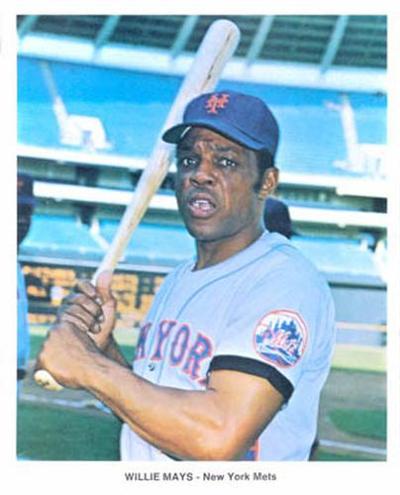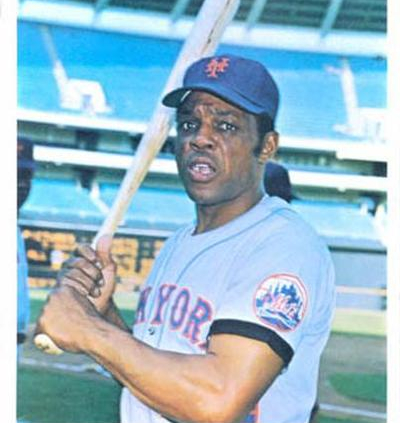May 21, 1972: Phooey in Philly! Mets win 11th in a row thanks to Tom Seaver, Willie Mays
 The Mets had terrific momentum in May 1972.
The Mets had terrific momentum in May 1972.
They conquered their competition with a 10-game winning streak, and looked to keep it going when ace hurler Tom Seaver took the mound on May 21 at Veterans Stadium for the last game of a four-game series against the Philadelphia Phillies.
With two all-time greats leading the charge—Seaver and recently acquired Willie Mays—New York won 4-3 for its 11th straight victory.
Seaver had led the National League in strikeouts the previous two seasons. His 2.82 ERA topped the NL in 1970. An outstanding 1.76 ERA led the majors in 1971. By the May 21 contest, Seaver had compiled a 6-1 record in 1972.
His counterpart was Steve Carlton; Philadelphia’s menacing lefty was 5-3 on his way to leading the majors with 27 wins in ’72 and the NL in ERA (1.97), strikeouts (310), and innings pitched (346⅓). The Phillies had a subpar season with 59 wins, but Carlton received the Cy Young Award.
Unlike the powerful Mets—who won the 1969 World Series and remained competitive in the early 1970s—Philadelphia had suffered a highly significant downturn in recent years. Baseball fans in the City of Brotherly Love hadn’t enjoyed a winning record since 1967.
The Phillies delivered a sixth-place finish in the NL East in ’71, resting 28 games below .500 and 30 games behind the first-place Pirates, who won the World Series against Baltimore in seven games.
The 1972 season started on a promising note with 15 wins in the first 25 games. But a five-game losing streak—including the first three games of the Mets series—caused some frowns among the land of the cheesesteak lovers. Philadelphia started strong against the kings of Queens, as Carlton struck out the side—Mays, Bud Harrelson, and Tommie Agee in the top of the first inning.
Further, the home team drew first blood with a run in the bottom of the first when Tim McCarver doubled and Greg Luzinski’s single sent him home. Tommie Agee’s error on Luzinski’s hit—one of 11 miscues the Mets center fielder made that season—allowed the 21-year-old slugger to second base, but Willie Montañez’s grounder to Ted Martínez at second halted the hopes of Phillies fans.
Philadelphia buoyed its left-hander to a three-run cushion when Montañez walked in the bottom of the fourth and Tom Hutton followed with a home run. It was a rare occasion for Hutton; he homered only four times in 1972, his first season in Philadelphia after an offseason trade from the Los Angeles Dodgers.
Philadelphia Inquirer sportswriter Bruce Keidan credited Phillies skipper Frank Lucchesi with a “last-minute managerial brainstorm[,]” using left-handed hitters Hutton and Ron Stone against the mighty Seaver in place of righties Deron Johnson and Mike Anderson.1 Perhaps the most relevant factor was that Hutton hit well against Seaver, compiling a .320 average in 50 career at-bats, including three home runs.
Carlton kept the Mets in goose eggs through five innings and added four strikeouts to his ledger: Martínez, Jones, and Seaver twice. A checked swing by the Mets’ pitcher in the bottom of the fifth prompted an argument by Lucchesi, who thought that Seaver swung; home-plate umpire Harry Wendelstedt ejected Lucchesi. The protest was moot because Carlton whiffed Seaver.
Through five innings, Philadelphia’s star pitcher had not allowed any Met to hit safely. Then Mays came to bat in the top of the sixth. New York had traded for the icon 10 days before, giving the San Francisco Giants $50,000 and pitcher Charlie Williams.
The player who wore number 24 was neither the runner nor batsman he used to be. But he could still smack the ball at times. This was one of them—he led off with a double and scored on Agee’s two-run homer, making the score 3-2.
Carlton was still on the mound with a one-run lead in the top of the eighth. Jim Beauchamp pinch-hit for Seaver and singled. Mays followed with a two-run homer, putting the Mets on top, 4-3.
It was the Say Hey Kid’s second home run as a Met and the 648th of his career. “I’m not taking any individual credit,” said Mays after the game. “When you start doing that, the team comes apart, and you start losing. This gang is all pulling together.”2
A less than stellar physique belied the batting prowess of the aging icon, who had turned 41 earlier in the month. New York Daily News columnist Dick Young noted, “Now, a mess of flab and rusted reflexes, he simply hits doubles and home runs in the most dramatic ways.”3
“Never sell a superstar short, even if he is 41,” declared Lucchesi.4
Still, Mays hadn’t performed well against Carlton, batting .177 in 62 at bats. Only five hits were extra-base hits. The May 21 game had two of them. Mays batted .250 in 1972 and played in 88 games—19 for the Giants and 69 for the Mets.
Mets reliever Danny Frisella stifled the home team over the next two innings to secure the 4-3 victory.
In the Mets’ three victories before the Philadelphia game, Mays was also a significant factor. “He’s just the type of player who makes things happen,” summarized Seaver, who ended ’72 with a 21-12 record, tied with Catfish Hunter, Stan Bahnsen, and Jim Palmer for fifth in the majors in wins.5
Both Seaver and Mays noted that the players strike during spring training had delayed the process of getting in shape and working through the usual kinks that arise during the offseason. Seaver racked up only three strikeouts, far below his average of seven strikeouts per game in 1972. But the right-hander took it in stride. “I’m still making numerous bad pitches to every batter. I throw the slider wrong, the curveball wrong, the fastball wrong. If I can be a winning pitcher the way I’m throwing, I just don’t understand it.”6
Carlton showcased his trademark endurance, going the full nine innings against the visitors. In 1972—his first year with the Philadelphians after coming to the City of Brotherly Love from the St. Louis Cardinals in a trade for Rick Wise on February 25—he led the majors with 30 complete games. The loss was the sixth of a 10-game losing streak for the Phillies, who were on their way to 19 losses in 20 games and another sixth-place finish.
Power was palpable as Carlton tallied nine strikeouts. Martinez and Jones each whiffed twice in addition to Seaver’s dual strikeouts; Mays, Harrelson, and Agee accounted for the other three. But New York’s six hits were enough to add an 11th straight entry in the “W” column.
This NL East battle took 2 hours and 2 minutes to finish for the Veterans Stadium crowd of 57,267.7 Aside from seeing two future Hall of Famers on the mound—plus Mays in the twilight of a career in the majors dating back to Harry Truman’s presidency—it was Bat Day.
In the Mets’ recent chain of wins, six of the 11 games were decided by one run. It was a terrific catharsis for the team and fans mourning the untimely passing of manager Gil Hodges at the beginning of the season. Just two days shy of his 48th birthday, Hodges died from a heart attack; beloved coach Yogi Berra succeeded him. The victory escalated the Mets’ record to 25-7 and a six-game lead over the second-place Pirates.
New York’s NL team soon quieted. Losing records in June, July, and August threw the Mets from their early pace of success. When the ’72 season ended, the Mets had a respectable third-place 83-73 record, putting them two games behind the Cubs and 13½ games behind the pennant-winning Pirates.
Acknowledgments
This article was fact-checked by Bruce Slutsky and copy-edited by Len Levin.
Sources
In addition to the sources cited in the Notes, the author consulted Baseball-Reference.com and Retrosheet.org for pertinent information, including the box score and play-by play.
https://www.retrosheet.org/boxesetc/1972/B05210PHI1972.htm
https://www.baseball-reference.com/boxes/PHI/PHI197205210.shtml
Notes
1 Bruce Keidan, “Record Crowd Sees Mays Beat Phils,” Philadelphia Inquirer, May 22, 1972: 23.
2 Dick Young, “Mays Dazes Phils, 4-3, on HR for Mets’ 11th,” New York Daily News, May 22, 1972: 66.
3 Young.
4 “‘Never Sell Superstar Short’—Frank Lucchesi,” United Press International, Lebanon (Pennsylvania) Daily News, May 22, 1972: 28.
5 “A Never-Ending Love for Mets and Willie,” Associated Press, Binghamton (New York) Evening Press, May 22, 1972: 20.
6 Bob Waters, “Willie’s Turn Again as Mets Roll On,” Newsday (Long Island, New York), May 22, 1972: 64.
7 It was an impressive turnout—the second biggest crowd for a National League day game. Al Harvin, “Mets Capture 11th Straight, 4-3 on Mays’s 2-Run Homer in 8th,” New York Times, May 22, 1972: 47.
Additional Stats
New York Mets 4
Philadelphia Phillies 3
Veterans Stadium
Philadelphia, PA
Box Score + PBP:
Corrections? Additions?
If you can help us improve this game story, contact us.


